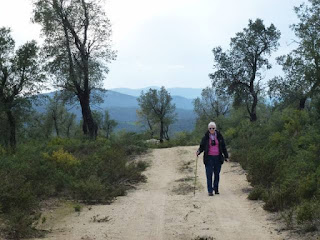The village name
means “flat island”, and it lies a mile along the road from the campsite. It’s
slightly longer by a much more scenic route via the beach. This way, you take a
path alongside a rambla, a dry ravine, that runs down to the sea, and then walk
along the beach. There is a path on both sides of the rambla, fairly close to
the edge. Only after studying the photo underneath, do you realise how undercut
the edge is. It’s a good 30 feet drop, so don’t jump about on the path.
At the end of the
rambla a wooden stairs leads to the beach itself. We’re heading for the cluster
of buildings in the distance.
20 minutes later
we’re in the village, on the prom, and looking at some excavated Roman remains,
apparently kilns. The flat island, after which the village is named, is in the
background.
The most
interesting structure in the village, and the one we come to next, is the old
bath house: Los Banos de la Marrana. These were public baths opened in 1901,
using water from hot thermal springs that had been on site for centuries.The baths
fell into disuse in the 1950’s and are not now accessible inside, although on
past visits we were able to enter and view the sad decay and graffiti. The
exterior gives a much more satisfactory and picturesque appearance.
On a small headland
is the church, the Ermita de Nuestra Senora del Carmen, patron saint of the
sea. It was planned in 1928 but only built in 1960, so is relatively new.
The church address
is, strangely, Calle Elefante, Elephant Street, so could Hannibal have perhaps
passed this way, maybe to take a bath.
The next photo
shows our usual destination: the Pensionista. Originally set up as an old folks
social venue, it’s now open to all as a very reasonably priced café. The chairs
and tables sprawl all over the front under the palm trees so there’s a lovely
view of the coast and the church thrown in.
Isla Plana has plenty of small shops and a small supermarket, so we don’t
need to go far for top-up shopping. Now it’s back down the beach to our caravan
home to enjoy another exceptional evening light.




















